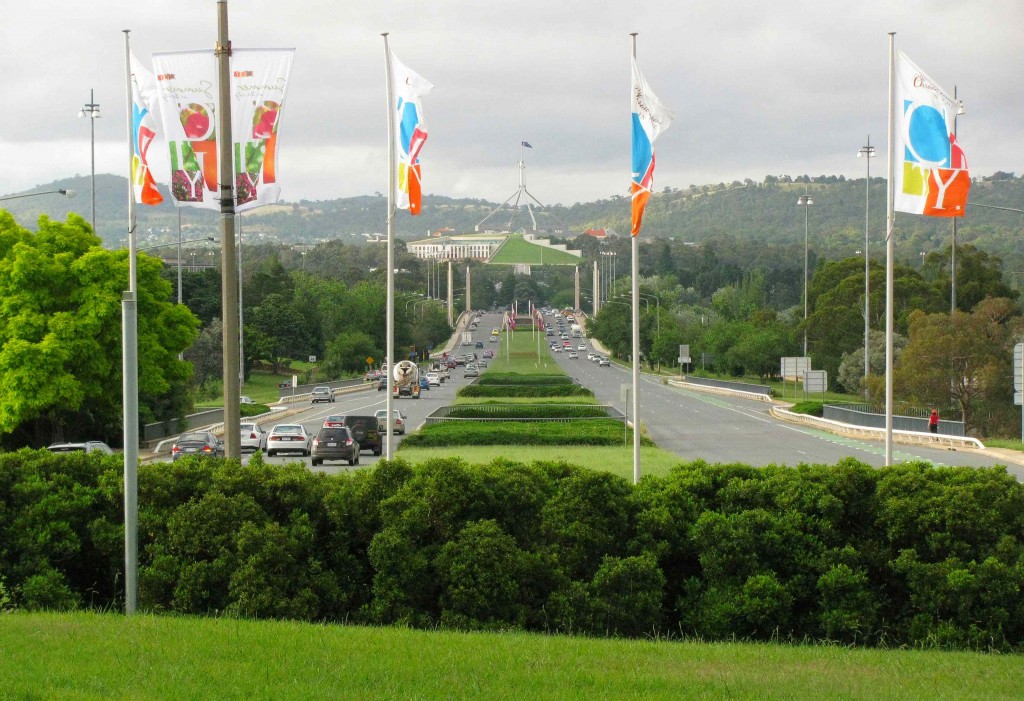
View of Commonwealth Avenue from City Hill, with Parliament House in Rear Centre (© Magi Nams)
Again, cloudy and pleasantly cool weather greeted me in Canberra’s early morning as I strolled south along Northbourne Street to City Hill, a circular park across Lake Burley Griffin from and in direct line with Capital Hill and Parliament House, the seat of Australia’s national government. Within the park, copses of pines and cedars towered over the lawn, the cedars like clusters of solemn men or a magical place to play hide ‘n seek. I spied rock doves, a pied currawong, Australian magpies, magpie-larks, and cheeky superb fairy-wrens that definitely played hide and seek in the cedars.
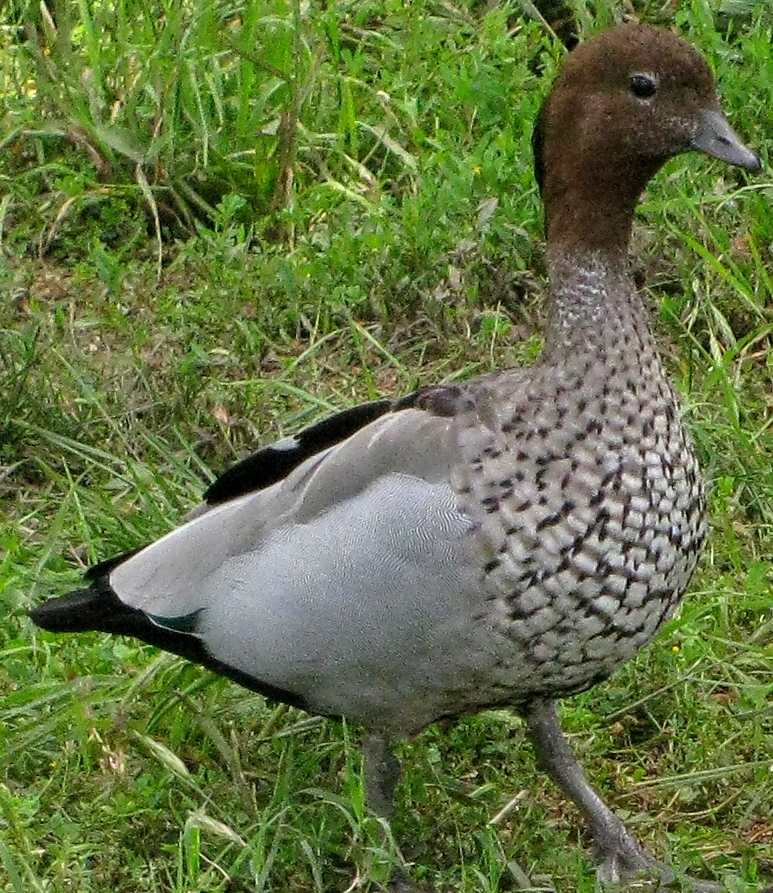
Australian Wood Duck (© Magi Nams)
I left City Hill and followed the northwest shore of Lake Burley Griffin in the direction of the National Museum of Australia located on a peninsula jutting southward into the lake. Australian wood ducks foraged on the lawn adjacent to the lake, and a pair of black swans sailed majestically on the water, the adults accompanied by a quintet of beige-plumaged cygnets. Noisy miners called questioning ‘whit?‘ from shade trees along the shore, and welcome swallows cruised over water and land with seemingly effortless ease. I shared the lakeside path with runners, walkers, and cyclists, none of whom returned my nods of greeting, and only a couple of whom responded to my ‘Good morning’s. Perhaps the population of Canberra is more reserved or indifferent than that of Townsville, where my parkway excursions elicit easily and frequently exchanged greetings.
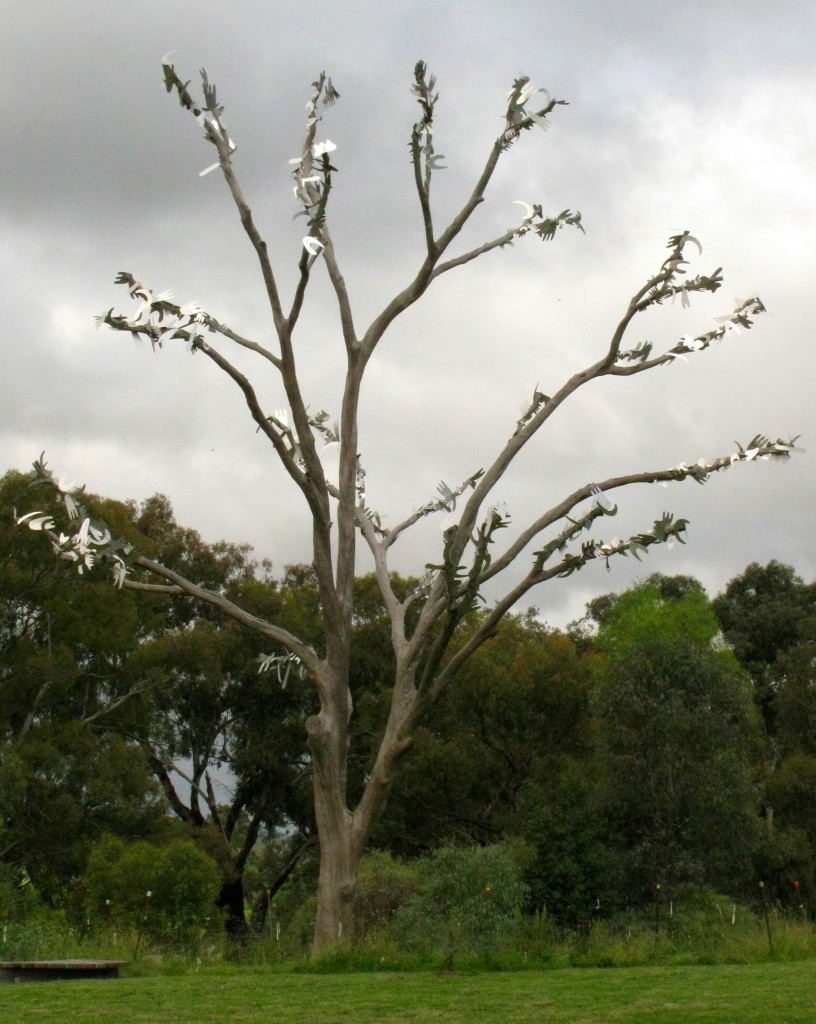
Witness, by Dadang Christano (© Magi Nams)
As I neared the museum, I spotted an intriguing tree with branches glinting silver and black, which turned out to be an art installation commissioned by the Australian National University Art Collection and constructed by Dadang Christano. Called Witness, the tree appeared to have hands and boomerangs uplifted to the sky, as if beseeching. Across a lawn and street from it, a rumpled, brick-red carpet of cement curled upward into the sky. Having visited both Melbourne and Sydney, I’d say that Canberra doesn’t possess the in-your-face panache of Melbourne or the artistic infrastructure and public buildings of Sydney; yet as I explored it, the planned city delighted me with nuggets of striking architecture and public art.
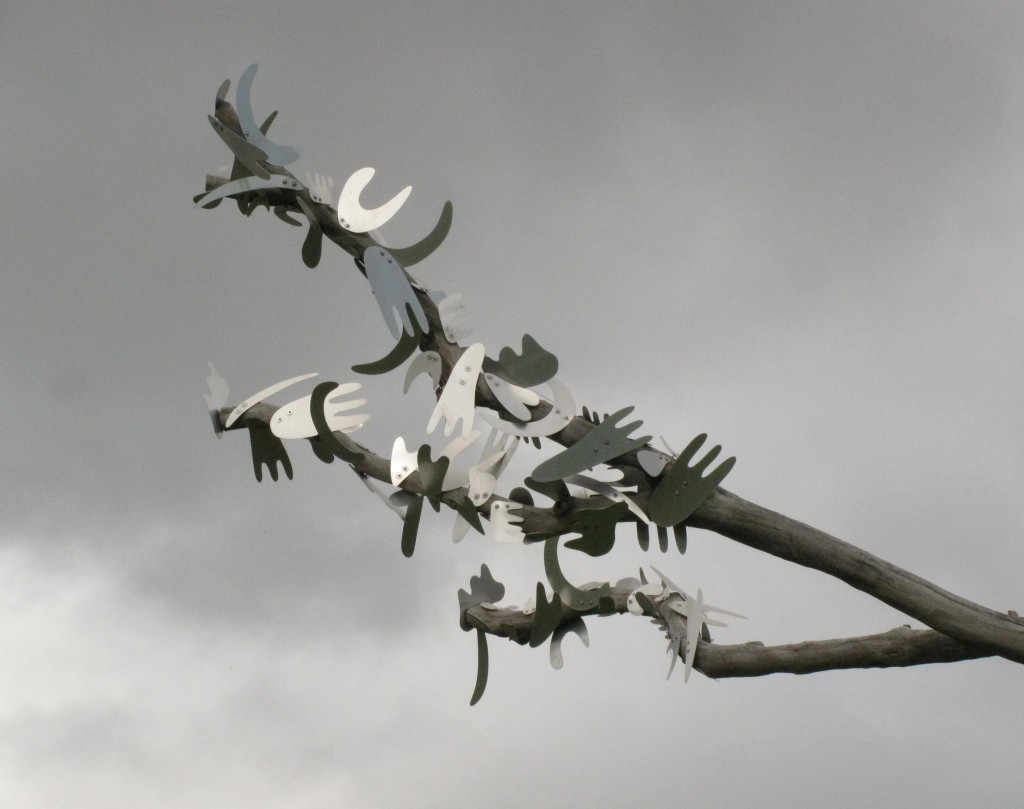
Detail from Witness Installation (© Magi Nams)
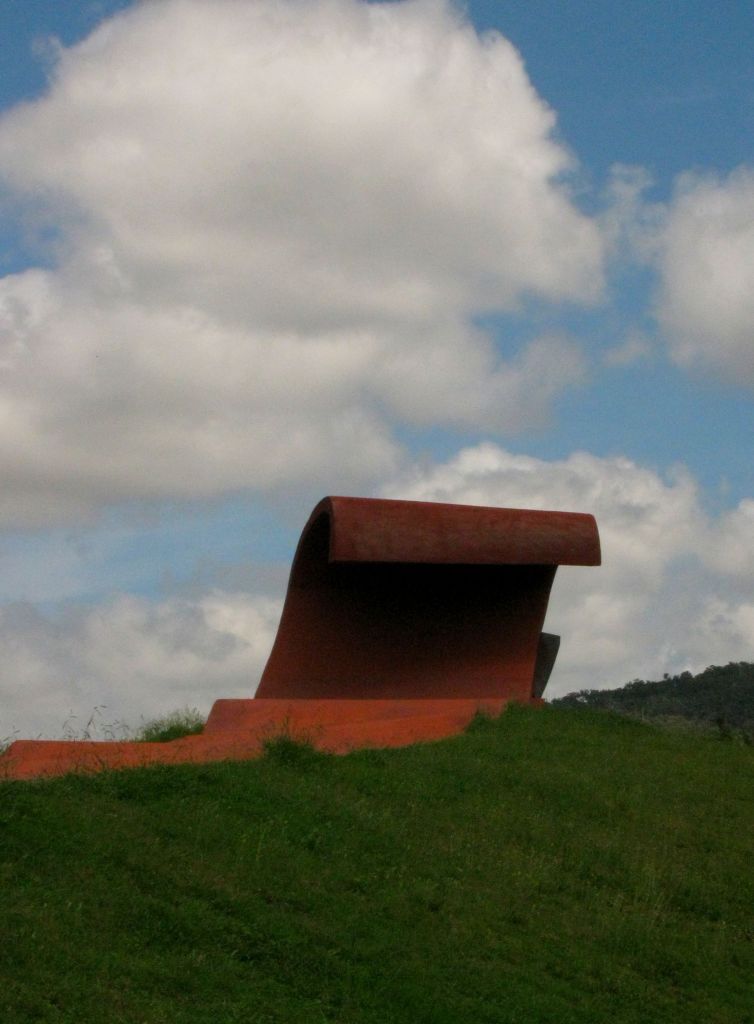
Public Art near the National Museum of Australia
The National Museum of Australia itself presented an intriguing face, its slanted roof slabs, giant wheel, and ‘tumbling domino’-like barrier bordering the outdoor Garden of Australian Dreams bringing to mind a fair-like atmosphere. Giant cicada sculptures formed seats on the lawn, an homage to the insects whose penetrating buzz emanated from gum trees adjacent to the museum and filled the air. Rock doves cooed from nesting sites on the building, and red-rumped parrots – exquisitely coloured and the first I’d seen – perched on a dead, fallen tree surrounded by water in the dream garden.
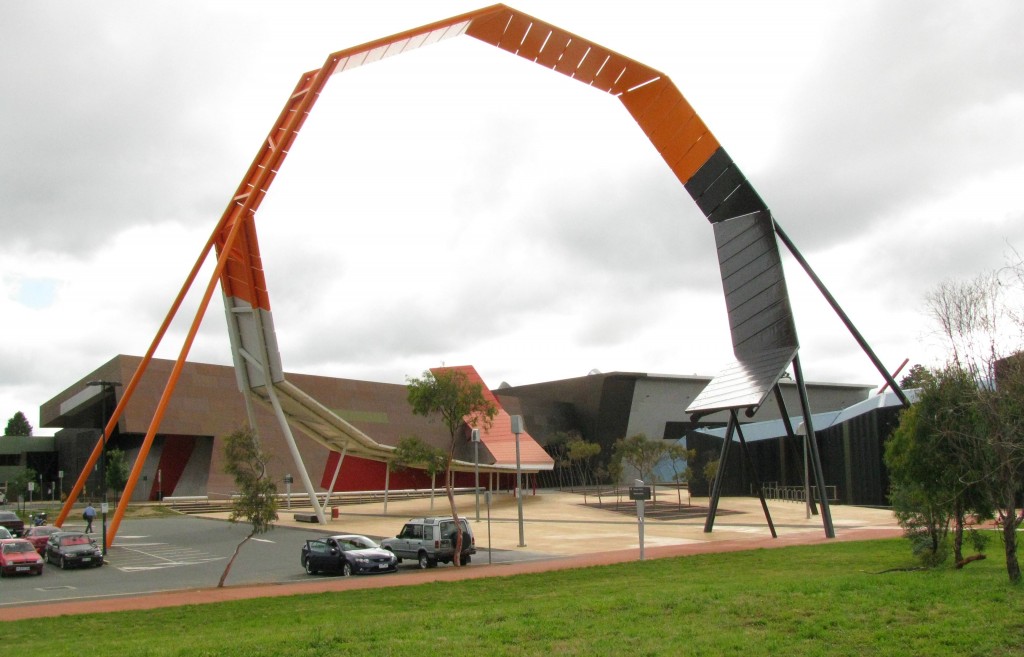
National Museum of Australia (© Magi Nams)
Within the museum, I spent most of the morning viewing two special exhibits, the first being the Canning Stock Route seen from the perspective of Aboriginal peoples, and the second a celebration of the 350th year of Britain’s Royal Society.
Before viewing the Canning Stock Route (CSR) exhibit, I had known that the CSR, which runs almost 1800 kilometres from Halls Creek to Wiluna in the state of Western Australia, is the longest historic stock route in the world and was developed to enable drovers to successfully move cattle through the desert lands south of the Kimberley cattle country. What I hadn’t known was the brutality with which Alfred Canning, leader of the Canning Exploration Party, had treated Aboriginal peoples inhabiting those desert lands during the surveying of the route. The exhibit, which was a stunning collection of Aboriginal art and stories, told of how Canning’s party had trespassed on Aboriginal lands and had captured Martu men to act as ‘guides.’ The Martu were handcuffed, chained at night and sometimes during the day, fed poorly, and provided with salty water. When a thirst-ravaged man was released, he immediately ran to a traditional water soak, where the whites subsequently dug a well to water cattle herds. Aboriginals attempting to obtain water from the wells built along the route frequently damaged them and were chased away from their traditional water supplies. This caused a fracturing of complex Aboriginal social structure based on family relationships and land occupation.
Between 1911 and 1931, only eight mobs of cattle were droved on the CSR (round trip took seven months); however after wells were improved, 300 to 800 cattle were moved each year on the route, which had the reputation of being the toughest stock route in Australia. The CSR still exists and is now a magnet for 4WD adventurers, as well as having portions still used for stock transport. A section of it passed through one of the stations on which Vilis and Janis assisted with biodiversity studies in Western Australia in May and June. Aboriginal peoples call the CSR yiwarra kuju – ‘one road’ – and today Aboriginal art centres dot the desert surrounding it. They produce vibrant paintings like those in the exhibit, the canvases echoing the colours of the desert and incorporating circular images that represent those brutally-sought-after waterholes or wells.
When I entered the Royal Society exhibit next door to the Canning Stock Route exhibit, I stepped into a different world – that of British explorers and scientists commissioned by the Society to explore and document the far reaches of the earth. One of these was Lieutenant and then Captain James Cook – the most emminent navigator of his time – who during his epic voyage on the Endeavour (1768-1771), documented the transit of Venus across the sun, circumnavigated New Zealand, and explored the east coast of Australia. A letter from Cook dated November 30, 1768, to the Secretary of the Royal Society, Charles Morton, stated that Cook was unable to procure any ‘worthy observations’ of the transit of Venus from Rio de Janeiro due to a heavy guard on the ship by the Portuguese army. Another letter dated May 5, 1776, and addressed to Royal Society President Sir John Pringle, discussed Cook’s methods of maintaining exceptional health among his crew during the three-year voyage (1776-1779) of the Resolution. His onboard health scheme included an abundance of fresh water and fresh vegetables, vitamin-rich saurkraut and lemon and orange juice, portable soup, breakfasts and dinners incorporating wheat and oatmeal, and the herbal cure-all, wort of malt. Cook ran a tight and tidy ship, insisting on the cleanliness of clothes and hammocks. He aired out his ship and dried it below deck by blowing smoke from fires through it. All this, he detailed in a neat, precise script with flourishes adorning d‘s at the end of words and dark arrows of ink indicating the conclusion of paragraphs (no indentation at new paragraphs). Courteously, Cook ended the 1776 letter with the words: ‘Sir, Your Most Obliged and Most Humble Servant, James Cook’.
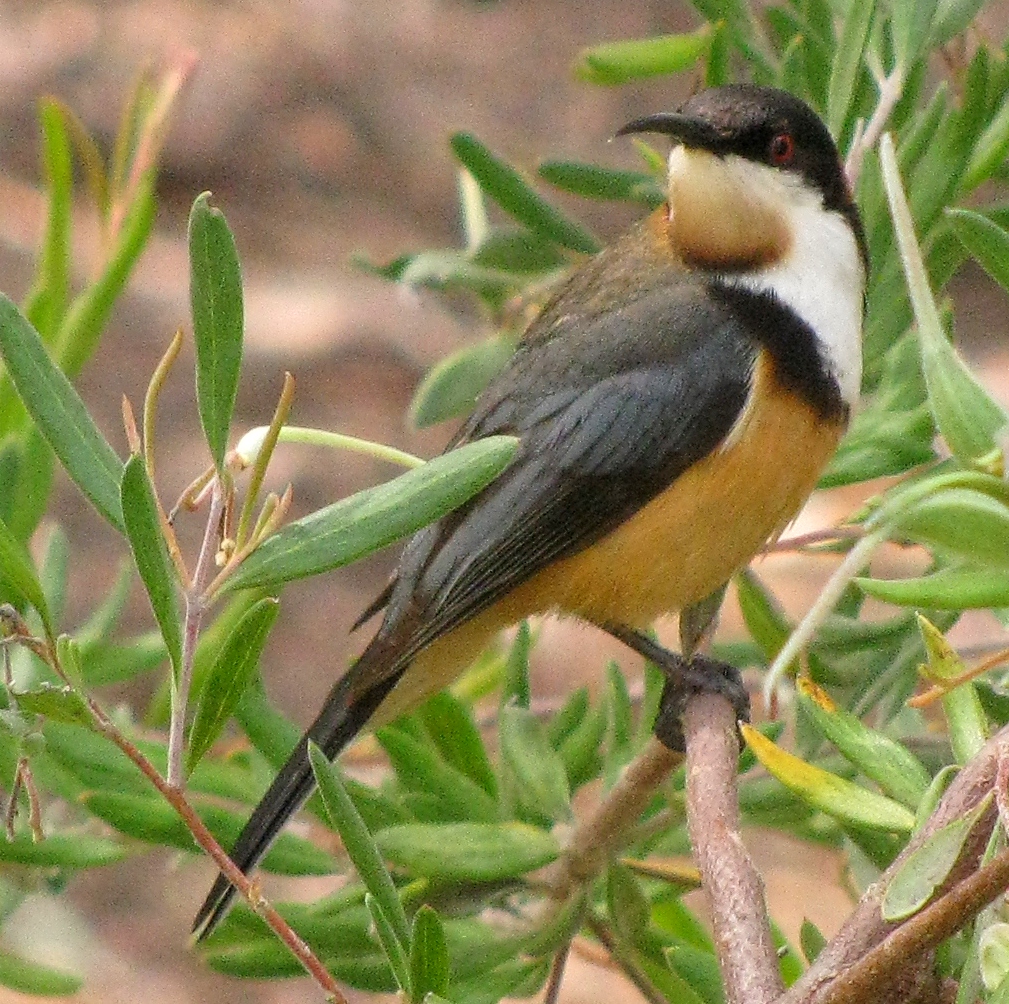
Eastern Spinebill (© Magi Nams)
Having arranged to meet Vilis for lunch, I hurried from the museum – passing the spent bodies of cicadas littering the cycling path and ‘red-carpet’ walkway ending in that enticing curl up into the sky – to the university, and after lunch hustled again to the Australian National Botanic Gardens, to which I had yesterday promised myself to return. There, white-winged choughs emitted mewling squeals while foraging on the ground, and male blackbirds sang tunes so musically lovely I could almost forgive them for being an introduced species. Eastern spinebills and red wattlebirds foraged for nectar in flowering shrubs, male Australian king parrots lit the gum forest with their scarlet heads, and tiny red-browed finches skulked among shrub twigs in the rock garden. Again, I haunted the eucalypt lawns in search of gang-gang cockatoos, and again I dipped on that species.
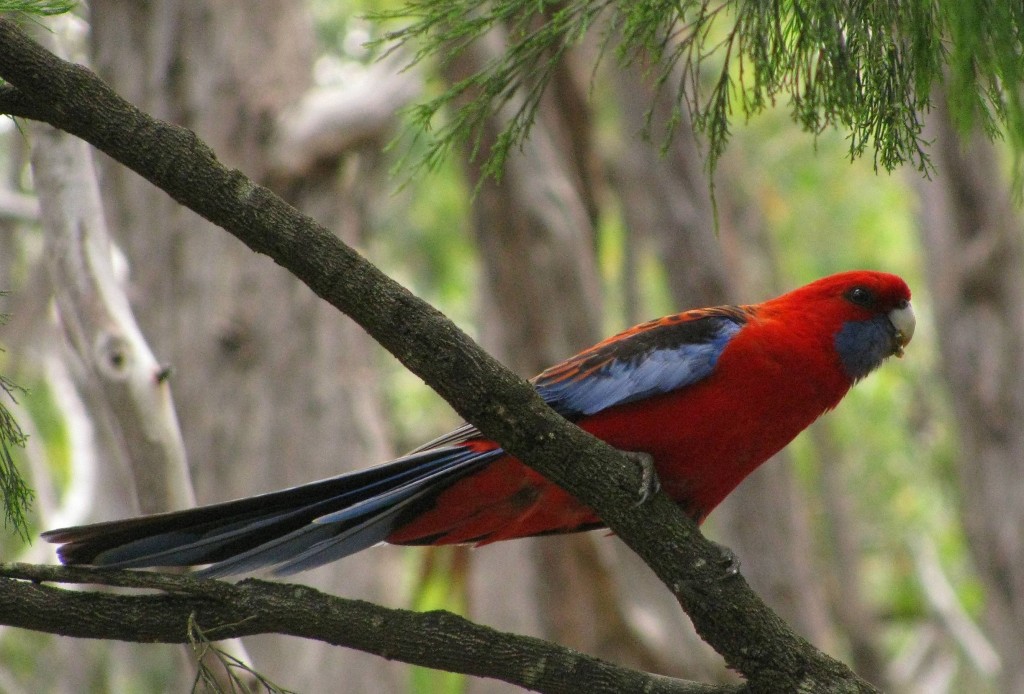
Crimson Rosella (© Magi Nams)
Eventually I left the lawns to climb a steep, rocky path to the summit of Black Mountain, an 812-metre peak rearing up to the west of the botanic gardens. My panting, sweaty passage through open eucalypt woodland in the mid-day heat was heralded by Australian ravens and monitored by several crimson rosellas that flew up from the ground only a few metres in front of me. On gaining the summit, I realized that views of the city (other than those from the Telstra Tower located atop the peak) were screened by trees. I rested in shade, sucked up an orange, and identifed a chestnut-rumped heathwren flitting about in heaths and stunted trees, the tiny bird’s chestnut rump, cocked tail, pale eyeline, and dark streaks on its chest offering clear evidence of its identity.
Then I headed downhill, passed quickly through the gardens – where so many common browns (butterflies) floated between flowering shrubs so as to distract me from bird movements – and explored a western reach of Sullivan’s Creek, spotting a purple swamphen on its bank and a family of dusky moorhens on an exposed patch of terra firma within the creek. A white bridge overhung by huge weeping willows caught my eye, its structured loveliness completely at odds with the disorder of native woodland through which I had earlier bushwalked. Yet both had their place within the bounteous green spaces of Canberra.
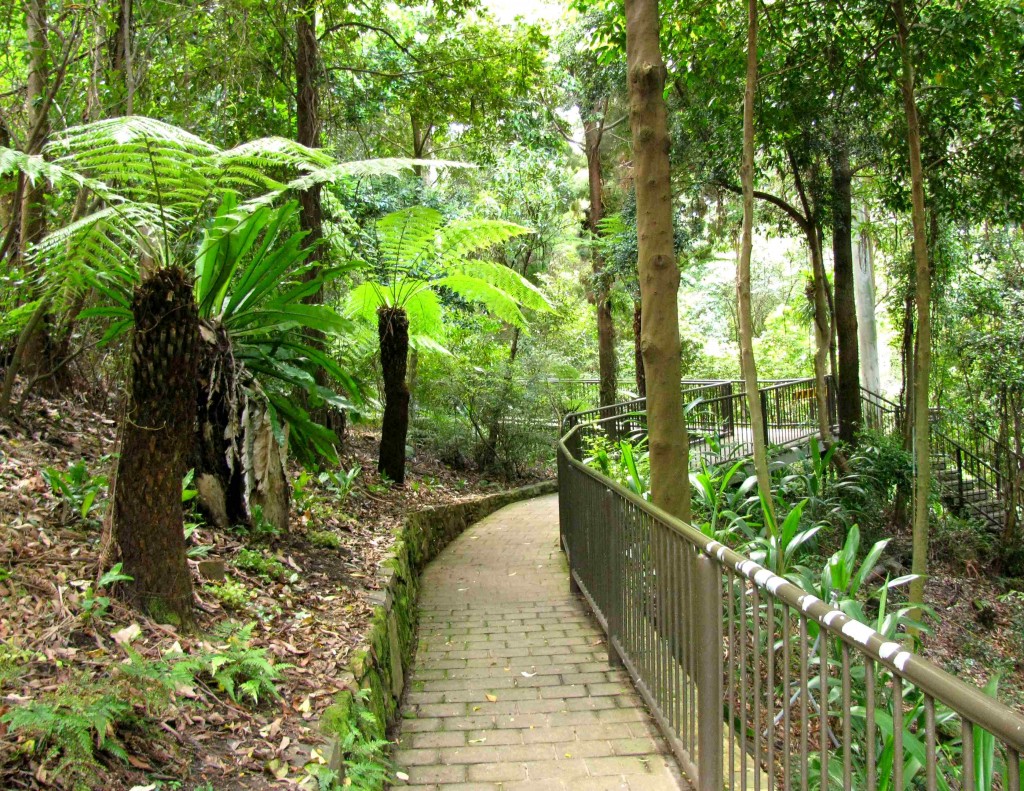
Australian National Botanic Gardens (© Magi Nams)
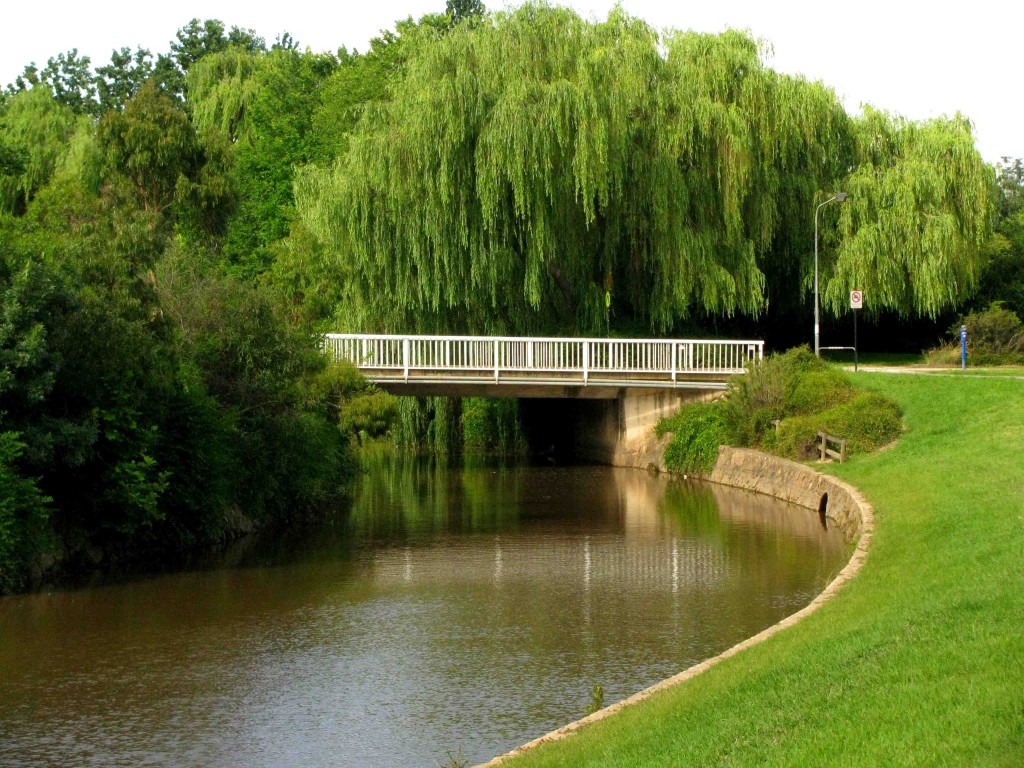
Bridge over Sullivan’s Creek, Canberra (© Magi Nams)
Today’s birds: rock doves, pied currawong, Australian magpies, magpie-larks, superb fairy-wrens, starlings, masked lapwing, noisy miners, little black cormorants, welcome swallows, grey fantails, black swans and cygnets, Australian wood ducks, sulphur-crested cockatoos, silver gulls, Australian raven, black-faced cuckoo-shrike, reed warblers, *red-rumped parrots, crested pigeon, Pacific black ducks, white-faced heron, white-winged choughs, red-browed finches, crimson rosellas, red wattlebirds, *chestnut-rumped heathwren, common bronzewing, Australian king parrots, blackbird, laughing kookaburras, olive-backed orioles, white-browed scrubwrens, purple swamphen, dusky moorhen. (*lifelist sighting). Also observed rabbits, water dragons, and common browns (butterflies).

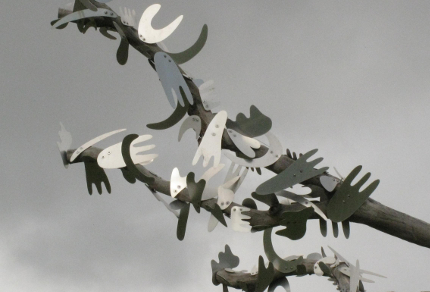

Your comment for Magi Nams – I took a photo last night of a large butterfly sitting on my sasanqua(sp?) camelia – have just identified it from your blog as a female orchard swallowtail – is it a Queensland butterfly?